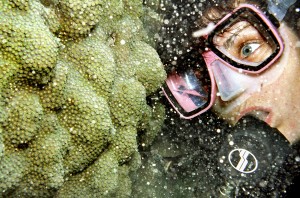 FLORIDA KEYS — Sparked by the August and September full moons, a rare and wondrous underwater exchange of reproductive cells heralds the continued survival of coral reefs and creates a fascinating experience for divers.
FLORIDA KEYS — Sparked by the August and September full moons, a rare and wondrous underwater exchange of reproductive cells heralds the continued survival of coral reefs and creates a fascinating experience for divers.
According to researchers, corals use multiple reproductive strategies. Nearly all large reef-building species release millions of gametes once a year in synchronized mass spawnings. This spectacular white excretion enables the immobile animals to send their eggs and sperm into the water in massive quantities.
When egg and sperm unite, the resulting larval-stage “planula” swims to the surface to drift in the current and grow. After some time — two days to two months — the planula settles to the bottom where it grows into a polyp. The polyp grows into a coral head by asexual budding that creates new polyps.
This annual “broadcast spawning” is believed to maximize the chances of fertilization, yet overwhelm predators with more food than they can consume. The exact cues triggering the fragile phenomenon remain unclear but are believed to be linked to water temperatures and tidal and 24-hour light cycles. Scientific observations also indicate a strong connection between the coral spawn and seasonal lunar cycles.
In August 2009, the first cultured corals — cultivated to help rebuild the reef — were discovered spawning after only two years, the first time it had been observed in the wild. That followed transplant efforts off Key Largo and the Upper Keys spearheaded by Ken Nedimyer, a coral restoration expert and president of the Coral Restoration Foundation.
“The goal is to get them to reproduce successfully so the corals that have spawned here can settle 10 miles or 50 miles from here,” Nedimyer said. “What we’re trying to do is put the girls and the boys back together in the same room so that they’ll make babies.”
Though the polyp release cannot be guaranteed to happen on the exact date, this year full moons fall on Tuesday, Aug. 24, and Thursday, Sept. 23. Divers can check with local dive operators about participating in coral spawning night dives scheduled around those dates.
In addition to coral reproduction, coral restoration is an attraction for people who love the reef. Amoray Dive Resort is offering a combination of coral transplanting seminars, restoration dives and (potential) coral spawn night dives Aug. 11-13 as well as Aug. 26 through Sept. 2, when world-famous underwater naturalists Ned and Anna DeLoach are to host their third annual sea critter seminars. For more information, visit www.amoray.com.
For accommodations, visit the Florida Keys & Key West website at www.fla-keys.com.
# # #
